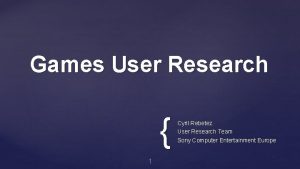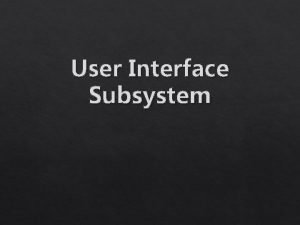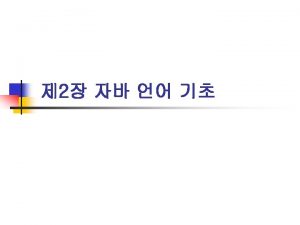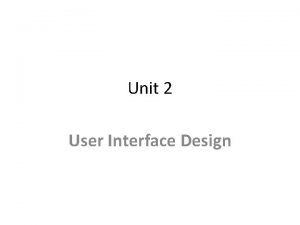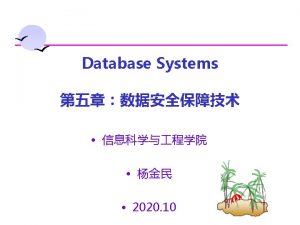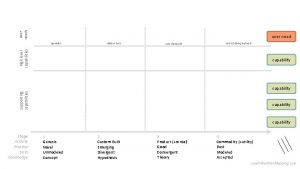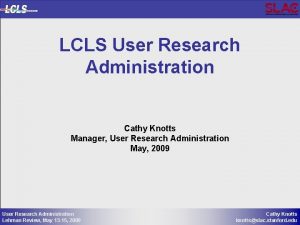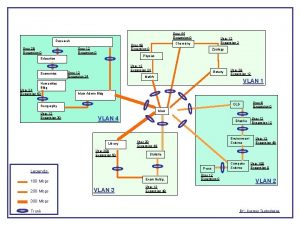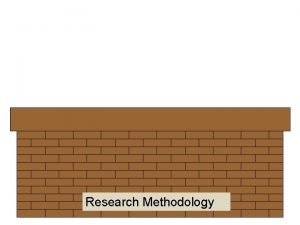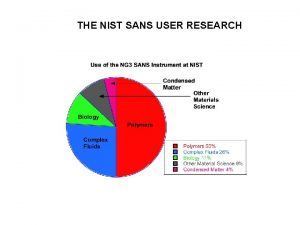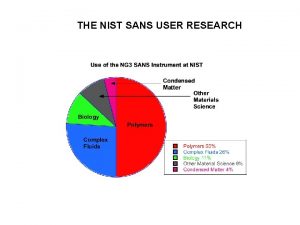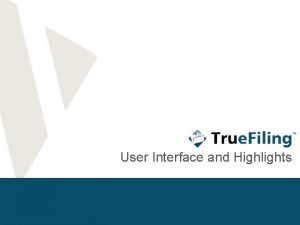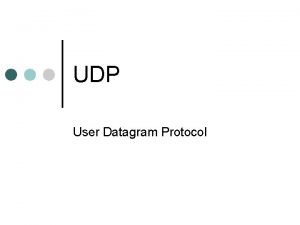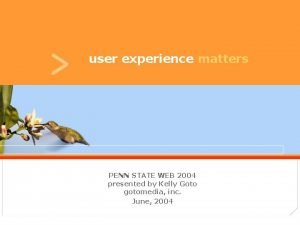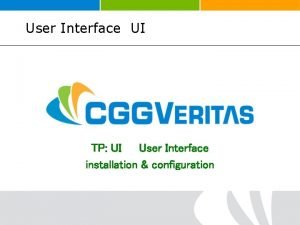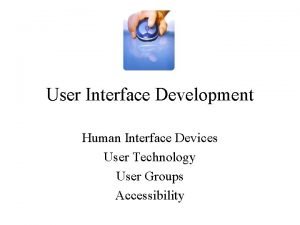What is user research User research is the



































- Slides: 35


What is user research? User research is the act of interviewing prospective and actual users of your products to gain clarity on a number of objectives. You might use it to figure out why people aren’t adding recommended products to a cart, why they’re not clicking through your emails on mobile phone, or why adoption of your application has fallen significantly.

What is user research? You may also be developing a new product or redesigning a website and know you want to do it differently this time around. All of these are great reasons to let your users tell you how they feel about your product.

“UX isn’t UX without research. ” Conducting user research is just one part of the equation. Afterwards, you have to act on that feedback to make new product decisions or enhancements. Depending on your role in the project, you may not agree with some of the feedback. If this is the case, remember that you’re not the end user. Your day is likely consumed with interacting with the website or application, which isn’t representative of a typical user’s usage.

Types of user research methods The following research methods outline 5 different methods for starting those conversations. This list isn’t meant to be exhaustive— it’ll cover the basics. Before we jump in, let’s define a few terms: • Facilitator: user research professional who plans and executes the research, gathers feedback, and reports all of that back to the project team

Types of user research methods • Participant: a user who’s part of the research process

Types of user research methods • Recruiting: the act of locating your product’s users to conduct a research test

Types of user research methods • Compensation: users are usually compensated for their time as a participant.

Types of user research methods • Usability lab: a traditional lab where tests are conducted. There are typically 2 rooms separated by a 2 -way mirror for observation purposes.

User interviews are the keystone of user research, grounding all additional approaches, methodologies, and deliverables in the act of conducting an actual conversation with your users. They can take place in traditional usability labs, remote via phone or web-based video, or the place in which your users typically engage with your digital product. This could be an airport, retail store, personal home, or a medical clinic, to name some examples.

User interviews Interviews can range from multi-week planned events to guerrilla-style interviews based on just minutes or hours of planning. This flexibility is key depending on the UX maturity of your organization and the funding available. “User interviews are the keystone of user research. ”

Usability test A usability test is conducted to validate an in-progress concept or a live product currently being used, or to drive UX changes after analytics and feedback indicate a usability problem. This research can take place in a traditional usability lab or on-location as part of a contextual inquiry.

Usability test A standard usability test involves specific tasks and will usually be tightly scripted in order to pinpoint specific issues. Facilitators can follow up with probing questions to dive into more detail. Participants will be encouraged to “think aloud” as they describe their thoughts about navigating through the tasks. Feedback tends to be more accurate and relevant because users are asked to state the first thing that pops into their head. Let participants think deeply about their responses, and they could edit them. That skews feedback.

Contextual inquiry A contextual inquiry is conducted to understand how users interact with a product, or a prototype of a new product, in the exact setting it’ll be used. So it likely won’t happen in a usability lab. Locations can range from participants’ homes, retail environments, airports or train stations, classrooms, medical offices, and more. This type of research can involve more planning and perhaps a higher cost due to the variations on recruiting and compensation.

User experience competitive user analysis A user experience competitive analysis is conducted to understand how your users are also using your competitors’ products. If the product you’re launching will be part of a crowded field, use your competitors’ websites and applications to learn what works and what doesn’t. Learning from these users and identifying mental models will help you capitalize on things done well and avoid potentially fatal mistakes.

User experience competitive user analysis A UX competitive analysis differs from more traditional competitive analysis that’s rooted solely in documenting data such as competitor offerings, market share, and strategy.

Heuristic and expert analysis evaluation A heuristic or expert analysis is conducted to evaluate a website or application against agreed upon design principles. User research and user experience professionals evaluate the system and gather issues. Those issues are then classified to what principle it violates and are assigned criticality to give direction to the team.

Heuristic and expert analysis evaluation Because these types of research activities don’t typically involve users, they can be conducted when there’s no budget available to recruit users for a larger -scale test. Even though users aren’t always engaged, it’s best to have researchers who are familiar with your users conduct these evaluations so they can focus on known issue areas. Additionally, typically a group of 2 -3 professionals conduct the analysis to ensure as many issues as possible

Heuristic and expert analysis evaluation A heuristic can also be used as a precursor to almost any other methodology, meaning that by evaluating a system to find usability problems you can inform interviews, usability tests, and more.

Additional methods There a number of additional types of research that can be employed depending on the need and maturity of your organization: • A/B testing • Surveys (in-person, email, web based, etc. ) • Click analysis • Eye tracking • Diary studies • Focus groups • Task time studies

Additional methods There a number of additional types of research that can be employed depending on the need and maturity of your organization: • A/B testing • Surveys (in-person, email, web based, etc. ) • Click analysis • Eye tracking • Diary studies • Focus groups • Task time studies

Additional methods There a number of additional types of research that can be employed depending on the need and maturity of your organization: • A/B testing • Surveys (in-person, email, web based, etc. ) • Click analysis • Eye tracking • Diary studies • Focus groups • Task time studies

Additional methods There a number of additional types of research that can be employed depending on the need and maturity of your organization: • A/B testing • Surveys (in-person, email, web based, etc. ) • Click analysis • Eye tracking • Diary studies • Focus groups • Task time studies

Additional methods There a number of additional types of research that can be employed depending on the need and maturity of your organization: • A/B testing • Surveys (in-person, email, web based, etc. ) • Click analysis • Eye tracking • Diary studies • Focus groups • Task time studies

Additional methods There a number of additional types of research that can be employed depending on the need and maturity of your organization: • A/B testing • Surveys (in-person, email, web based, etc. ) • Click analysis • Eye tracking • Diary studies • Focus groups • Task time studies

Additional methods There a number of additional types of research that can be employed depending on the need and maturity of your organization: • A/B testing • Surveys (in-person, email, web based, etc. ) • Click analysis • Eye tracking • Diary studies • Focus groups • Task time studies

Test plan The test plan represents the culmination of planning for your research effort. The gathering of this information should be collaborative and involve interviews with stakeholders and subject matter experts. Collaboration isn’t absent from this process. All parties should have ample time to review the document to ensure they’re comfortable with the approach.

Test plan • Objectives: What do you want out of the research effort? • Methodology: How are you going to gather insight? • Participants: Who are you gathering insight from? • Outline: What will the flow of the session be? • Test environment: Where will the research will take place? • Project schedule: When can you expect the research to take place, when will initial results be available, and when will the full report be delivered?

Test plan • Objectives: What do you want out of the research effort? • Methodology: How are you going to gather insight? • Participants: Who are you gathering insight from? • Outline: What will the flow of the session be? • Test environment: Where will the research will take place? • Project schedule: When can you expect the research to take place, when will initial results be available, and when will the full report be delivered?

Test plan • Objectives: What do you want out of the research effort? • Methodology: How are you going to gather insight? • Participants: Who are you gathering insight from? • Outline: What will the flow of the session be? • Test environment: Where will the research will take place? • Project schedule: When can you expect the research to take place, when will initial results be available, and when will the full report be delivered?

Test plan • Objectives: What do you want out of the research effort? • Methodology: How are you going to gather insight? • Participants: Who are you gathering insight from? • Outline: What will the flow of the session be? • Test environment: Where will the research will take place? • Project schedule: When can you expect the research to take place, when will initial results be available, and when will the full report be delivered?

Test plan • Objectives: What do you want out of the research effort? • Methodology: How are you going to gather insight? • Participants: Who are you gathering insight from? • Outline: What will the flow of the session be? • Test environment: Where will the research will take place? • Project schedule: When can you expect the research to take place, when will initial results be available, and when will the full report be delivered?

Test plan • Objectives: What do you want out of the research effort? • Methodology: How are you going to gather insight? • Participants: Who are you gathering insight from? • Outline: What will the flow of the session be? • Test environment: Where will the research will take place? • Project schedule: When can you expect the research to take place, when will initial results be available, and when will the full report be delivered?

Findings report After the research effort is complete, a research findings report should be delivered to synthesize and report common insights. Types of documents delivered will depend on the methodology used, but you can expect a document that contains data, quotes, photos, videos, and enhancement recommendations. As a follow-up to the test plan, all items listed above should be included to ensure everyone on the team is aware of how this feedback was gathered.

http: //img. blog. yahoo. co. kr/ybi/1/1 c/f 6/cliffordmlarsen/folder/717992/img_717992_1359004_3? 1103025176. jpg
 Single user and multi user operating system
Single user and multi user operating system Rtos multitasking
Rtos multitasking Hát kết hợp bộ gõ cơ thể
Hát kết hợp bộ gõ cơ thể Bổ thể
Bổ thể Tỉ lệ cơ thể trẻ em
Tỉ lệ cơ thể trẻ em Chó sói
Chó sói Tư thế worm breton là gì
Tư thế worm breton là gì Chúa sống lại
Chúa sống lại Môn thể thao bắt đầu bằng từ chạy
Môn thể thao bắt đầu bằng từ chạy Thế nào là hệ số cao nhất
Thế nào là hệ số cao nhất Các châu lục và đại dương trên thế giới
Các châu lục và đại dương trên thế giới Công của trọng lực
Công của trọng lực Trời xanh đây là của chúng ta thể thơ
Trời xanh đây là của chúng ta thể thơ Mật thư anh em như thể tay chân
Mật thư anh em như thể tay chân Làm thế nào để 102-1=99
Làm thế nào để 102-1=99 Phản ứng thế ankan
Phản ứng thế ankan Các châu lục và đại dương trên thế giới
Các châu lục và đại dương trên thế giới Thơ thất ngôn tứ tuyệt đường luật
Thơ thất ngôn tứ tuyệt đường luật Quá trình desamine hóa có thể tạo ra
Quá trình desamine hóa có thể tạo ra Một số thể thơ truyền thống
Một số thể thơ truyền thống Cái miệng bé xinh thế chỉ nói điều hay thôi
Cái miệng bé xinh thế chỉ nói điều hay thôi Vẽ hình chiếu vuông góc của vật thể sau
Vẽ hình chiếu vuông góc của vật thể sau Thế nào là sự mỏi cơ
Thế nào là sự mỏi cơ đặc điểm cơ thể của người tối cổ
đặc điểm cơ thể của người tối cổ Giọng cùng tên là
Giọng cùng tên là Vẽ hình chiếu đứng bằng cạnh của vật thể
Vẽ hình chiếu đứng bằng cạnh của vật thể Phối cảnh
Phối cảnh Thẻ vin
Thẻ vin đại từ thay thế
đại từ thay thế điện thế nghỉ
điện thế nghỉ Tư thế ngồi viết
Tư thế ngồi viết Diễn thế sinh thái là
Diễn thế sinh thái là Dạng đột biến một nhiễm là
Dạng đột biến một nhiễm là Bảng số nguyên tố
Bảng số nguyên tố Tư thế ngồi viết
Tư thế ngồi viết



































